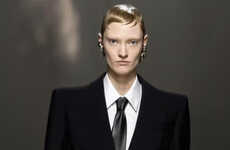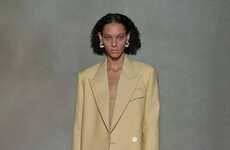
Emma Watson for The New York Times Style Magazine is Chic
Sarah Robson — August 19, 2012 — Fashion
References: artpartner & designscene.net
Emma Watson for The New York Times Style Magazine looks dapper and sophisticated. She is captured by Alasdair McLellan as the new covergirl for the upcoming Fall 2012 issue.
The stylist Anastasia Barbieri has dressed Emma in chic tweed pantsuits, leather dress shoes, embroidered blouses and long fall jackets. Emma's hair has been pulled back into a tight textured bun, and her eyes are lined with a thick eyeliner. The masculine garment styles combined with Emma's pulled back tresses create an androgynous look that is debonair and composed.
Alasdair McLellan is a British photographer focusing on print and film who works with Art Partner, a leading artist agency. He photographs for popular brands including Topshop, H&M, Lucky Brand, Vogue and Louis Vuitton.
The stylist Anastasia Barbieri has dressed Emma in chic tweed pantsuits, leather dress shoes, embroidered blouses and long fall jackets. Emma's hair has been pulled back into a tight textured bun, and her eyes are lined with a thick eyeliner. The masculine garment styles combined with Emma's pulled back tresses create an androgynous look that is debonair and composed.
Alasdair McLellan is a British photographer focusing on print and film who works with Art Partner, a leading artist agency. He photographs for popular brands including Topshop, H&M, Lucky Brand, Vogue and Louis Vuitton.
Trend Themes
1. Androgynous Fashion - The rising trend of androgynous fashion is an opportunity for fashion brands to create garments that blur gender lines and appeal to a wider audience.
2. Gender-blurring Styles - The emergence of gender-blurring styles is disrupting the traditional boundaries of fashion, presenting opportunities for designers to experiment with unconventional and boundary-pushing designs.
3. Masculine-inspired Clothing - The growing popularity of masculine-inspired clothing presents an opportunity for fashion and retail brands to create new collections that cater to the demand for gender-neutral fashion styles.
Industry Implications
1. Fashion Industry - The fashion industry stands to benefit from the growing trend towards androgynous fashion and gender-neutral styles, by catering to a wider and more inclusive audience.
2. Retail Industry - The rise of gender-neutral fashion presents opportunities for retailers to expand their offerings and differentiate their brands in a crowded market.
3. Beauty Industry - The trend towards androgynous fashion is disrupting traditional beauty standards and presenting opportunities for beauty companies to market their products in new ways that cater to diverse consumer preferences.
6
Score
Popularity
Activity
Freshness























